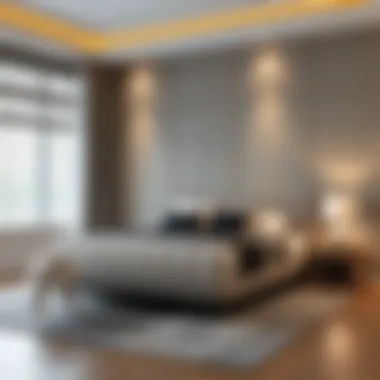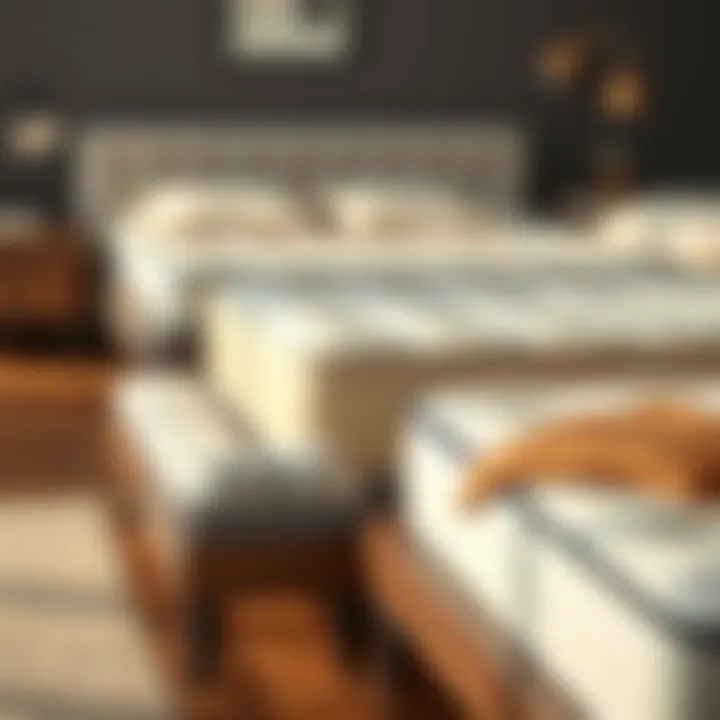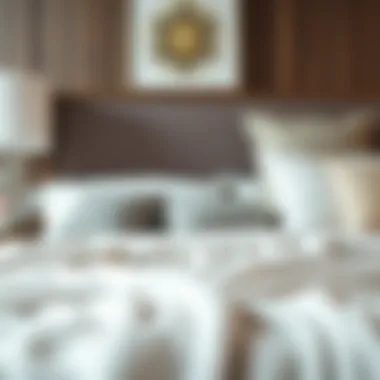Alternative Solutions for Queen Size Beds Without Box Springs


Intro
Diving into the world of queen-size beds without the traditional box spring is like unwrapping a gift—there are endless surprises waiting just beneath the surface. The allure of a bed setup without a box spring offers both style and functionality, meeting the growing demand for more contemporary, adaptable sleeping environments. Prospective buyers are eager to understand the practicalities involved in making such choices, particularly when it comes to achieving comfort, functionality, and an aesthetic that fits the bedroom vibe.
This guide aims to equip homeowners, interior decorators, and DIY enthusiasts alike with insightful information about how to navigate this innovative landscape. From bed frames that accommodate the absence of box springs to mattresses designed to support your worthy slumber, every detail counts. We’ll explore furniture design trends, practical tips for selecting the right overall size, and care methods to ensure longevity.
Furniture Design Trends
Current Styles and Themes
The beauty of modern furniture design lies in its ability to adapt to lifestyles, and the queen-size bed is no exception. Among the current trends, minimalism reigns supreme. Think of clean lines, natural materials, and a focus on functionality—no excess fluff here. Various styles, like Scandinavian and Industrial, have transcended through mainstream decor, showcasing attractive yet practical designs.
- Scandinavian Style: Neutral colors mixed with light wood accents.
- Industrial Style: Raw materials such as metal combined with reclaimed wood.
- Mid-Century Modern: A throwback with organic shapes and vibrant pops of color.
These styles lend themselves beautifully to beds without box springs. For instance, platform beds with a sleek frame can provide an arresting centerpiece while doing away with the bulk that accompanies box springs. The general theme is symmetry and balance, drawing attention to the structure itself rather than relying on external add-ons.
Color Palettes and Materials
Selecting the right color palette can evoke the mood of a space, making it crucial in a bedroom setting. Soft neutrals, whites, and earthy tones help create a tranquil environment, while bolder hues can express personality and create a focal point in the room. When considering colors, the following choices often resonate:
- Calm Grays
- Warm Beiges
- Deep Blues or Greens for a splash of personality
In terms of materials, the trend is leaning heavily toward sustainability without skimping on style. Bamboo and reclaimed wood are gaining traction, attracting eco-conscious consumers. Upholstered materials also offer comfort while ensuring a sophisticated appearance. The combination of natural fibers with elegant finishes often strikes a balance between rustic charm and modern chic.
"The choice of materials and colors can transform a simple bed into a work of art."
Practical Furniture Tips
How to Choose the Right Size
Choosing the appropriate size for your queen-size bed setup involves more than just measuring the mattress dimensions. Consider the overall layout of the room and how the bed will interact with other furniture elements. Allocating space for nightstands and ensuring there is room to maneuver around the bed is prime to installation. It's advisable to maintain at least 24 inches of walking space around the bed for optimal comfort.
Maintenance and Care for Longevity
Your bed is an investment that deserves attention. While box springs may require less frequent upkeep, mattresses and frames in a box spring-free setup need keen attention. Regularly rotating the mattress, using a protective cover, and wiping down the frame can prevent premature wear. Here are some quick tips for maintaining your setup:
- Rotate the Mattress every 3 to 6 months.
- Vacuum the Frame to remove dust and debris.
- Check for Loose Screws to maintain structural integrity.
- Use a Mattress Protector to guard against spills and stains.
In summary, opting for a queen-size bed without a box spring can open a world of possibilities, giving way to fresh designs while remaining functional. Through thoughtful selection of style, color, and maintenance, homeowners can create inviting spaces that reflect their personality and enhance their sleeping experience. Explore your options and allow your creativity to flow!
Prelims to Queen Size Beds
When it comes to bedroom essentials, the queen size bed stands out as a popular choice for many homeowners. Offering a middle ground between compact twin beds and spacious king-sized options, it caters to a diverse range of needs and preferences. Whether you’re a couple wanting to share space comfortably or a single sleeper who enjoys a bit more room, understanding the nuances of queen size beds can be beneficial.
As we dive into this exploration, it’s crucial to not just look at the measurements or style, but the overall implications of choosing a queen-sized setup. One thing to consider is the ideal balance between comfort and space efficiency.
Queen beds, typically measuring 60 inches wide and 80 inches long, provide generous sleeping space without overwhelming a typical bedroom. They can fit snugly in rooms that might be just a bit too small for a king but offer more space than a full-sized bed might allow.
Understanding Queen Size
Engaging with the queen size bed means embracing a variety of styles, mattress types, and potential accessories that support a blissful night’s rest. It’s more than a mere sleeping surface; it represents a foundation for a good night’s sleep and promotes healthy living. Knowing the dimensions helps you appreciate its practical placement in your home.
Benefits of a Queen Size Bed
On top of just size, a queen bed comes with several perks. First and foremost, it provides ample space for various sleeping styles. Couples will find it’s a comfortable compromise, with room to move without constantly bumping into each other. Also, it can serve multi-functional needs, doubling as a cozy haven for reading or working, whether it’s early morning or late at night.
- Versatility in Design: Queen size beds fit into nearly every type of decor. From vintage frames with elaborate headboards to minimalist platform styles, there’s something to match every taste.
- Accessibility: Many brands offer a range of budgets for queen-sized mattresses, making it easier to find something that fits your financial plan while still providing quality sleep.
- Ideal for Guests: If you frequently host visitors, having a queen bed allows them to enjoy a comfortable sleeping experience, which can boost their overall perception of your hospitality.
With so much value packed into a queen size bed, it’s clear why so many are drawn to this particular option in bedding. Understanding these aspects lays the groundwork for making informed choices regarding bed frames, accessories, and overall setup, especially when considering alternatives that do not require box springs.


The Role of Box Springs
Box springs have played a pivotal role in the art of bedroom design and functionality for decades. They were crafted with specific purposes in mind—providing support, enhancing mattress longevity, and increasing overall comfort during sleep. However, as homeowner preferences evolve, so do the discussions surrounding the necessity of box springs, especially concerning queen size beds.
Functionality and Purpose
The primary job of a box spring is to serve as a shock absorber for the mattress above. Think of a box spring as a sturdy foundation that can absorb stress, distributing weight evenly across the mattress. This setup helps maintain mattress integrity over time, prolonging its life. Further, a box spring can elevate the sleeping surface, making it easier to get in and out of bed.
Another important aspect of box springs is ventilation. They allow air to circulate around the mattress, which can help reduce heat retention and moisture buildup—two factors that can drastically affect sleep quality. By promoting airflow, box springs can keep the mattress fresher and more comfortable, creating a cool sleeping environment on hot summer nights.
However, while box springs do hold several benefits, they are not the only option available. As homeowners increasingly seek modernized solutions, alternatives like platform beds and other frame designs are making their way into the spotlight.
Challenges with Box Springs
Despite their advantages, box springs are not without their own set of challenges. One significant issue is their bulkiness. For many, the traditional box spring can feel cumbersome and may not blend seamlessly with modern interior designs. This view is partly why some homeowners opt for creative and minimalistic bed frame options.
Moreover, box springs can limit mattress choices. Not every mattress type is designed to work with these foundations. For instance, memory foam or latex mattresses often perform better on a solid, flat surface rather than a raised and springy framework. This can confound individuals looking for specific comfort levels while also upholding certain design aesthetics.
Consider also the cost—box springs can add an additional financial burden when purchasing a new bed setup. With furniture prices continuing to climb, homeowners may find it unwise to invest in a box spring when alternatives exist.
In sum, while box springs carry a historical importance in the realm of bedding, their practicality in today's market is up for debate.
In essence, as preferences shift, so too must our understanding of bed setups, moving beyond tradition to find what truly works best for individual needs and spaces.
The exploration into the role of box springs demonstrates the complexity of bedroom design decisions. As the landscape continues to change, being informed about all available options ensures that homeowners can create a sleeping environment that suits them best.
Exploring Bed Frame Alternatives
In the realm of bedroom design, the choice of bed frame can dramatically influence both aesthetics and functionality. For those opting for a queen size bed sans the traditional box spring, a deep dive into alternative bed frame styles is essential. This section will explore various options while emphasizing their merits, ensuring that homeowners, designers, and DIY enthusiasts find a frame suited to their tastes and practical needs.
Platform Beds
Platform beds are a popular choice for those looking to eliminate the box spring. These frames offer a low profile, depending on the design, and support the mattress with a solid, flat surface. One of their primary advantages is their ability to provide stability and strength, which can enhance the longevity of your mattress. Many platform beds come with built-in storage options, making them incredibly space-efficient. This is particularly useful in smaller rooms where every inch counts.
Moreover, platform beds can fit into various design aesthetics, from minimalist modern to more rustic styles. Their sleek profiles often create a clean look, reducing the clutter in a bedroom. Whether you lean towards wood, metal, or a combination of materials, platform beds provide an adaptable framework that resonates with diverse tastes.
Adjustable Bed Frames
Adjustable bed frames have gained traction in recent years for their unique ability to adapt to different sleeping positions. Whether you enjoy reading in bed, watching movies, or simply want to adjust your mattress's angle for health reasons, these frames can cater to your needs. The versatility of an adjustable frame can contribute significantly to comfort, especially for those who suffer from issues such as acid reflux or snoring.
This option often comes equipped with remote controls, allowing users to modify their positions easily. Additionally, many adjustable beds allow for paired smart technology, integrating sleep tracking and customizable settings that enhance the overall sleep experience. While they might carry a higher price tag than traditional frames, the potential health benefits could justify the investment for many individuals.
Slatted Frames
Slatted frames present another viable choice when foregoing a box spring. With horizontal slats that support the mattress, these frames create a breathable structure that can aid in cooling, which is essential for sleep quality. They distribute weight evenly across the frame, promoting better durability for your mattress.
The simple yet functional design of slatted frames allows them to complement various decor styles, from contemporary to classic. They can often be found in various finishes and materials, enabling a customization that fits your bedroom's color palette. One notable consideration is that slatted frames should have slats spaced appropriately to prevent the mattress from sagging, which can negate their effectiveness.
Low Profile or No-Profile Frames
For a more streamlined look, low profile or no-profile frames can perfectly fit the bill. These frames sit closer to the ground, providing a modern touch and making the bed appear less imposing in a space. They can be especially appealing for those who prefer a minimalistic aesthetic without sacrificing the comfort that a queen size bed delivers.
Low profile frames generally make it easier for individuals with mobility concerns to get in and out of bed, thereby enhancing accessibility. However, it’s crucial to consider mattress height when choosing this option to ensure an optimal sleeping experience. The integration of low-profile designs into a bedroom layout can create a stylish and cohesive feel while promoting ease of access.
In summary, when considering alternatives to box springs, exploring various bed frame options is essential for achieving both comfort and style in a queen size setup. Each of these frames has its unique benefits, allowing for personalized choices that reflect both aesthetics and practical needs.
Choosing the Right Mattress
Selecting the appropriate mattress is crucial when considering a queen size bed without a box spring. Since the mattress is the primary element contributing to comfort and sleep quality, understanding its characteristics is fundamental. A good mattress should align with your sleeping style, support your body, and fit your frame. It’s not just about softness or firmness; it impacts how well you sleep overall.
In today’s market, options abound—from foam to coils to hybrids—each with its own set of benefits. Choosing wisely can mean the difference between a restful night and tossing and turning. Moreover, a proper mattress can help in preserving health by providing adequate support, preventing back pain, and ensuring blood circulation is at its best. When delving into the specifics of mattress types, let’s explore the varied choices and what each can offer.


Types of Mattresses
Memory Foam
Memory foam mattresses are known for their contouring properties. They mold to the body shape, distributing weight evenly and reducing pressure points. This aspect is especially beneficial for those who suffer from joint pain or require extra support.
Key characteristic: Viscoelastic material that adjusts to body heat and weight.
Because of its adaptability, memory foam is a popular choice for many sleepers. However, it can retain heat, which some may find uncomfortable.
Advantages:
- Excellent motion isolation, ideal for couples
- Reduces pressure on joints
Disadvantages:
- Can be heat-retaining
- Some individuals may feel "stuck" due to its density.
Latex
Latex mattresses stand out due to their natural materials, whether it be synthetic or natural latex. They’re well-regarded for breathability and resilience.
Key characteristic: Bounciness and responsiveness, offering an “active” sleeping experience.
This flexibility allows for ease of movement, making it suitable for combination sleepers.
Advantages:
- Naturally hypoallergenic
- Durable and can last longer than other types
Disadvantages:
- Can be quite heavy
- Price point might be higher compared to other materials.
Innerspring
Innerspring mattresses use coils as their main support system. This traditional option is fitted with varying coil counts and configurations, adapting to different tyoes of sleepers.
Key characteristic: Springs that provide bounce and support, alongside comfort layers.
The specific design can greatly influence how supportive they are.
Advantages:
- Great airflow for cooler sleeping
- Often more affordable options available
Disadvantages:
- Potential for motion transfer if coils are not well designed
- May not provide the same level of contouring support as foam options.
Hybrid
Hybrid mattresses combine aspects of both foam and innerspring systems, aiming to capture the benefits of each. They usually have a core of pocketed coils with a top layer of foam, offering support and comfort together.
Key characteristic: A blend designed to meet diverse sleeping needs.
This variety makes hybrids appealing to a wider audience seeking a mix of features.
Advantages:
- Provides balanced support and cushioning
- Versatile for different sleeping positions
Disadvantages:
- Can be more expensive due to their complexity
- Quality can vary significantly based on manufacturer.
Mattress Thickness and Support
The thickness of the mattress plays a significant role in support and comfort levels. Generally, mattresses range from 8 to 14 inches thick, and the choice largely depends on personal preference and body type. A thicker mattress can provide extra plushness, but it also is important to ensure that it suits the frame and doesn’t create height issues that complicate getting in and out of bed. Considerations around mattress thickness are fundamental to setting up a comfortable and accessible sleep space.
Accessories for Box Spring-Free Beds
When opting for a queen size bed devoid of a traditional box spring, the right accessories become paramount. These elements not only enhance the functionality of your chosen setup but also contribute to overall comfort and aesthetics. Understanding the various accessories available helps homeowners, interior decorators, and even furniture retailers make informed decisions that cater to specific needs.
Bed Risers
Bed risers are a practical solution for those looking to elevate their sleeping arrangement. These simple devices can increase the height of your bed frame, offering several benefits.


- Increased Storage Space: With a bit of elevation, you can utilize the area under your bed for storing seasonal clothing, shoes, or even extra bedding.
- Improved Circulation: Raising the height can enhance air circulation around the mattress, promoting a cooler sleeping environment, which can be especially beneficial during warmer months.
- Accessibility: For individuals with mobility issues, a higher bed can make it easier to get in and out of bed without straining the back or knees.
Setting up bed risers is typically a straightforward task. You just slip them under each leg of the bed frame, and voilà—it’s like giving your bed a little boost! Be sure to choose sturdy risers that can support the combined weight of the bed and mattress, along with the sleepers.
Bedding Considerations
Selecting the right bedding is crucial when you choose a queen size bed without a box spring. The mattress sits directly on the frame or platform, and that presents some unique considerations.
- Fitted Sheets: Ensure your fitted sheets have deep pockets if your mattress is thick, as not all sheets will stay put on a thick surface.
- Comfort Layers: Depending on the type of mattress used, adding comfort layers, like mattress toppers, can enhance the sleep experience. A quality topper can provide extra cushioning and support, alleviating pressure points.
- Protective Covers: Investing in a mattress protector is smart. It shields against spills, allergens, and dust mites. Since the mattress is more exposed when not on a box spring, these covers can preserve its lifespan.
- Aesthetic Appeal: Since box springs often tucked away, your chosen frame style plays a big role visually. Opt for bedding that complements the design of your frame. Textures, colors, and patterns should harmonize to create a cohesive look in your bedroom.
A well-thought-out bed setup is like a fine-tuned instrument; each accessory plays its part in creating a harmonious sleep experience.
Practical Tips for Setup
Setting up a queen size bed without a box spring isn't just a matter of preference; it has significant implications for comfort, aesthetics, and efficiency in one's living space. Understanding practical tips for setup ensures that homeowners, designers, and DIY enthusiasts can make the most out of their sleeping arrangements.
Height Considerations
The height of your bed affects not just the ease of getting in and out, but also the overall look of the bedroom. A low bed can create a more modern and minimalist feel, while a higher setup might provide better sightlines and a sense of grandeur. Here are some factors to keep in mind:
- Personal Preference: Some people prefer a lower profile bed that feels closer to the ground, while others favor a higher frame for ease of access.
- Mattress Type: Different mattresses come with varying heights, and when coupled with the frame’s height, this can significantly impact the total elevation. Memory foam mattresses tend to be thicker than traditional innerspring varieties, for example.
- Storage Solutions: If you're utilizing a platform bed, consider if it has storage underneath or if you want to utilize bed risers to create more space for storage.
The height ultimately depends on balancing aesthetics and functionality.
Arrangements for Space Efficiency
Space efficiency is key when setting up a queen size bed without a box spring. In many homes, especially those with limited space, optimal arrangement becomes vital. Here’s how to tackle that challenge effectively:
- Placement of the Bed: Ensure the bed is positioned against a wall. This not only saves space but also creates a cozy nook for sleeping. However, staying mindful of leaving room for nightstands is crucial.
- Multi-Functional Furniture: Consider furniture that serves multiple purposes. For instance, using a storage ottoman as a footrest is a smart way to enhance utility without overcrowding the room.
- Utilizing Vertical Space: If the bedroom is on the smaller side, think of using the walls for shelving or hooks, rather than letting the floor get cluttered. This maximizes the area while keeping essentials within reach.
- Clear Pathways: When arranging furniture, leave enough walking space around the bed. This not only makes the room feel larger but also eases movement, which is essential for comfort and accessibility.
It's about finding the right balance between functionality and aesthetics. In a bedroom, where one seeks to relax, an overly cramped space can be counterproductive.
Maintenance of Box Spring-Free Beds
Maintaining a box spring-free bed requires a different approach than that traditional setup. It’s about keeping everything in tip-top shape while ensuring comfort andsupport is not sacrificed. Understanding the nuances of this maintenance can not only extend the lifespan of your mattress and frame but also enhance the overall sleeping experience. Care and maintenance is key, especially since many alternative configurations lack the natural height and support usually provided by a box spring.
Cleaning and Care for Mattresses
Cleaning your mattress regularly is important. Dust mites and allergens can build up quickly, creating an unhealthy sleep environment. Here’s how to care for your mattress without overcomplicating it:
- Vacuum Regularly: A quick vacuum with a hand attachment once every month can help get rid of dust and unwanted particles that settle on the surface. Be gentle, as you don’t want to damage the material.
- Spot Clean Stains: If a spill happens, address it immediately. Use a mix of cold water and mild detergent on a clean cloth to blot the area. Avoid soaking the mattress, as excessive moisture can lead to mold.
- Rotate Your Mattress: Rotating your mattress every three to six months can help prevent uneven wear. This is especially critical for foam and hybrid mattresses which might sag in specific areas if always faced one way.
- Use a Mattress Protector: Investing in a quality mattress protector can not only shield against spills and stains, but it also helps with allergens, prolonging the life of your mattress considerably.
Keeping it clean and integral can seem a bit of a hassle, but with a steady routine, it can turn into a simple task that you barely think about.
Sustainability Considerations
In today’s eco-conscious world, the sustainability of your bed setup is more important than ever. When choosing a mattress and frame without a box spring, consider materials and production processes. Here are some points to ponder:
- Material Choices: Look for mattresses made from natural or organic materials. Foam and latex mattresses often have eco-friendly options that use sustainable production processes. Brands like Purple and Avocado are known for their sustainable practices.
- Durability Matters: Higher-quality products, although they may cost a bit more upfront, often last longer. Durability means fewer replacements, which is better for the environment overall.
- Recycling Options: When it’s time to swap out your mattress, look for recycling options available in your area. Many companies offer take-back programs, so your old mattress doesn’t end up in a landfill.
- Support Local Businesses: Buying from local manufacturers can reduce shipping emissions, supporting the local economy while also lowering your carbon footprint.
"The choices we make when it comes to our beds can resonate far beyond our bedrooms, impacting our environment and wellness."
By choosing sustainable options and practicing conscientious maintenance, not only are you benefitting your sleep and health but also contributing to a healthier planet. This mindful approach is becoming ever more relevant in our consumer choices and is a key factor for those considering how their sleeping arrangements align with their values.
Finale
The discussion around queen size beds without box springs highlights an evolving trend in bedroom design, aligning comfort with modern aesthetics. As homeowners, designers, and DIY enthusiasts seek remedies to stress the potential downsides of traditional box springs, understanding the available options becomes paramount. Moving away from box springs presents benefits that cater to various needs and preferences. It not only opens the door to innovative bed frame styles but also complements the lifestyle that prioritizes both function and visual appeal.
Final Thoughts on Queen Size Beds Without Box Springs
Choosing a queen size bed without a box spring can be a wise move for many. The beauty of this choice lies in its flexibility, enabling individuals to tailor their sleep environment to their unique requirements. Different frame styles, such as platform and adjustable frames, provide abundant choices for homeowners who value both design and utility.
In addition, by selecting the right mattress—be it memory foam, latex, or innerspring—one can achieve ideal comfort without the limitations that come with traditional setups. It's also worth noting that maintaining these box spring-free configurations tends to be easier and more straightforward, as cleaning and care requirements differ from those of conventional beds.
These elements not only contribute to a seamless living space but also echo considerations for sustainability, as box spring-free setups frequently utilize materials and designs that align better with eco-friendly values.
Ultimately, making the shift away from box springs challenges conventional beliefs about bed setups, stirring curiosity and intrigue among those seeking to revamp their sleep spaces. Whether for aesthetic enjoyment or practical considerations, there’s little doubt that the allure of a box spring-free queen size bed will continue to gain traction among consumers.
So, as you contemplate which bed setup will grace your home, take these insights to heart. A thoughtful choice in bed style and accessories can set the tone for a bedroom that pairs elegance with ultimate comfort.



